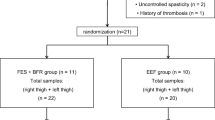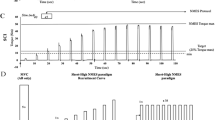Abstract
Four individuals with a spinal cord injury underwent 16 weeks of isometric electrical stimulation training to both legs for 60 min, five times per week during the first 5 months after injury, while two SCI individuals remained untrained. A baseline biopsy sample of the vastus lateralis muscle was obtained within 1 month of injury, and another biopsy sample was taken after a further 16 weeks. The untrained, paralyzed skeletal muscle displayed a reduction in (1) type I fibers (from 50% to 9%), (2) myosin heavy chain (MHC) I (from 27% to 6%), and (3) fiber cross-sectional area of type I, type IIA and type IIX fibers (−62%, −68%, and −55%, respectively) when compared to the baseline sample of muscle taken within 1 month of injury. In contrast, the trained group showed smaller alterations in type I fibers (from 49% to 40%) and MHC I composition (from 39% to 25%), while fiber cross-sectional area was similar to baseline levels for type I, type IIA and type IIX fibers (−3%, −8%, and −4%, respectively). In conclusion, electrical stimulation training can largely prevent the adverse effects of a spinal cord injury upon paralyzed human skeletal muscle if applied soon after the injury.
Similar content being viewed by others
Author information
Authors and Affiliations
Additional information
Accepted: 15 December 1999
Rights and permissions
About this article
Cite this article
Crameri, R., Weston, A., Rutkowski, S. et al. Effects of electrical stimulation leg training during the acute phase of spinal cord injury: a pilot study. Eur J Appl Physiol 83, 409–415 (2000). https://doi.org/10.1007/s004210000263
Issue Date:
DOI: https://doi.org/10.1007/s004210000263




